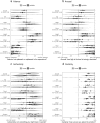Soundgen: An open-source tool for synthesizing nonverbal vocalizations
- PMID: 30054898
- PMCID: PMC6478631
- DOI: 10.3758/s13428-018-1095-7
Soundgen: An open-source tool for synthesizing nonverbal vocalizations
Abstract
Voice synthesis is a useful method for investigating the communicative role of different acoustic features. Although many text-to-speech systems are available, researchers of human nonverbal vocalizations and bioacousticians may profit from a dedicated simple tool for synthesizing and manipulating natural-sounding vocalizations. Soundgen ( https://CRAN.R-project.org/package=soundgen ) is an open-source R package that synthesizes nonverbal vocalizations based on meaningful acoustic parameters, which can be specified from the command line or in an interactive app. This tool was validated by comparing the perceived emotion, valence, arousal, and authenticity of 60 recorded human nonverbal vocalizations (screams, moans, laughs, and so on) and their approximate synthetic reproductions. Each synthetic sound was created by manually specifying only a small number of high-level control parameters, such as syllable length and a few anchors for the intonation contour. Nevertheless, the valence and arousal ratings of synthetic sounds were similar to those of the original recordings, and the authenticity ratings were comparable, maintaining parity with the originals for less complex vocalizations. Manipulating the precise acoustic characteristics of synthetic sounds may shed light on the salient predictors of emotion in the human voice. More generally, soundgen may prove useful for any studies that require precise control over the acoustic features of nonspeech sounds, including research on animal vocalizations and auditory perception.
Keywords: Animal vocalizations; Emotion; Formant synthesis; Nonverbal vocalizations; Open source; Parametric synthesis; Voice synthesis.
Figures




References
-
- Anikin, A. (2018). The perceptual effects of manipulating nonlinear phenomena and source spectrum in human nonverbal vocalizations. Manuscript submitted for publication.
-
- Anikin A, Lima CF. Perceptual and acoustic differences between authentic and acted nonverbal emotional vocalizations. Quarterly Journal of Experimental Psychology. 2018;71:622–641. - PubMed
MeSH terms
LinkOut - more resources
Full Text Sources
Other Literature Sources

